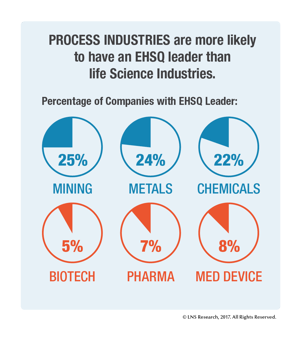On Tuesday, September 18, LNS Research hosted the webcast, “Unlocking Value from Shop Floor to the Enterprise: Digitally Transforming Risk, Quality and Safety.” The presentation explained how integrating the critical functions of quality and safety can mean strategic value for the enterprise beyond the sum of what they offer separately. The discussion included an examination of how industrial organizations use advanced digital technologies to transform risk, quality, and safety management to deliver unprecedented value from the shop floor and throughout the enterprise.
Click here to speak with Dan Jacob.
Q1: My company manufactures chemicals and is looking into EHS and quality convergence. How common is this in process industry?
 A1: Interestingly, this varies quite a bit by industry. According to LNS, the average convergence of EHSQ across all industries is 12%, with process industries such as chemicals on the high end of the spectrum, and manufacturers with complex quality regulatory compliance such as life sciences on the low end of the spectrum
A1: Interestingly, this varies quite a bit by industry. According to LNS, the average convergence of EHSQ across all industries is 12%, with process industries such as chemicals on the high end of the spectrum, and manufacturers with complex quality regulatory compliance such as life sciences on the low end of the spectrum
In general, converging ISO management systems makes it easier to unite processes, and therefore teams, leadership, and technology. Some industries, such as life sciences, aerospace, and automotive have quality requirements that expand on ISO 9001, extensively in some cases. The additional quality and regulatory compliance complexity make it challenging to converge due to practical concerns about workload and divergent competencies. Process industries generally do not have specialized quality requirements, and therefore leaders that see value in convergence are in a stronger position to do so.
Q2: You spoke about multiple connections to integrate EHS and quality. Where should we start?
A2: Rather than point to an area of operations or technical integrations, you should start with the strategic objectives of your company. What does the company see as critical moving forward? Then consider convergence. Where will converging people, leadership, metrics, technologies, and processes the best help attain these goals? There are apparent low-hanging fruits where duplication is unnecessary, and there is a strong better together story, such as document management/control, management of change, and corrective actions. However, your company may decide to converge these in the background during a more strategically aligned transformation. Use this information to determine whether the project makes sense, and if it does, use it to guide the pitch to top management.
Secondly, carefully consider where you want to start physically. Which sites demonstrate success, have less change reluctance and have shown success with previous improvement projects? Which are the closest to your final state? In some cases, the transformation will happen as a big bang, but that is increasingly rare – the much more common approach is, to begin with, a pilot approach.
Q3: Getting agreement across different sites in just EHS is tough. How can companies get buy-in on the value of integrating EHS and quality processes across multiple sites?
A3: This is a common issue. Ever hear this? “I’m happy to harmonize - let’s all do it my way!” Both EHS and quality teams often build in process and competency distinctions that vary by site, business unit, product. Harmonization can be quite tricky.
However, this is universally true - it isn’t specific to EHS and quality. These practical tips often help:
- Get an executive sponsor that will strongly back the project. The sponsor will help you overcome objectors.
- Assess what works and doesn’t work, typically by site, and by stakeholder. Listen, and build in feedback where possible. Also, this will provide ammunition to keep project momentum up when you hit inevitable stumbling blocks.
- Build an internal brand for the project and put on your marketing hat. As a part of the brand, define the value to the different stakeholders, and market this value to the stakeholders. Show where you listened, how this will improve their day-to-day, but also be realistic with challenges. Risk analysis and leveraging this in the project can help improve outcomes and show due diligence.
Q4: What's the best way to translate data collected into actions or changes for performance improvement?
A4: This is a great question. The best way to translate the data is to follow the Digital Innovation Cycle. This cycle takes data/insights, engages multiple stakeholders to adapt to the new insights, generates off-tempo decisions that can disrupt the market, and then acts. Because of this, it’s important to consider multiple roles and include top management in this assessment.